The 1% Club: Insights into Wealth Inequality

Introduction
Wealth inequality remains a pressing issue across the globe, with a small percentage of the population controlling a disproportionate amount of resources. This phenomenon has given rise to terms like the ‘1% Club,’ which refers to the wealthiest individuals who hold significant financial power and influence. Understanding the implications of this group is crucial for discussions on economic policy, social justice, and sustainability.
The Rise of the 1% Club
According to a report from Oxfam, the wealthiest 1% of the world’s population now owns more than half of the global wealth. This trend has been exacerbated in the wake of economic crises, such as the COVID-19 pandemic, which has widened the income gap, putting enormous pressure on the working and middle classes. The ‘1% Club’ symbolizes not just wealth but also the influence these individuals wield in shaping economies and societies.
Impact on Society and Economy
The concentration of wealth within the ‘1% Club’ has profound implications. Economically, it affects consumer behaviour, investment patterns, and even government policy. Wealthy individuals often have the means to invest in assets that grow exponentially, creating barriers for average citizens who lack such capital. Moreover, political lobbying by the wealthy can steer legislation in ways that benefit them, potentially at the expense of broader societal interests.
On a social level, the existence of the ‘1% Club’ breeds resentment and leads to calls for reform. Movements for wealth redistribution, such as universal basic income and higher taxation on the wealthy, are gaining traction. These movements reflect a growing awareness and concern among the middle and lower classes about the sustainability of the current economic model.
Conclusion
The significance of the ‘1% Club’ lies not only in the wealth they control but also in the societal implications of such disparity. As wealth inequality continues to rise, discussions surrounding economic equity and fairness will remain at the forefront of public discourse. The coming years may see an increased push for reforms aimed at reducing the wealth gap, fostering a more inclusive economic environment. For readers, understanding the dynamics of the ‘1% Club’ is essential for engaging in informed discussions about societal values, economic policies, and the direction of future reforms.









